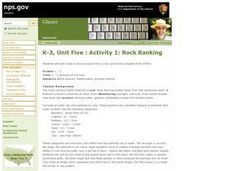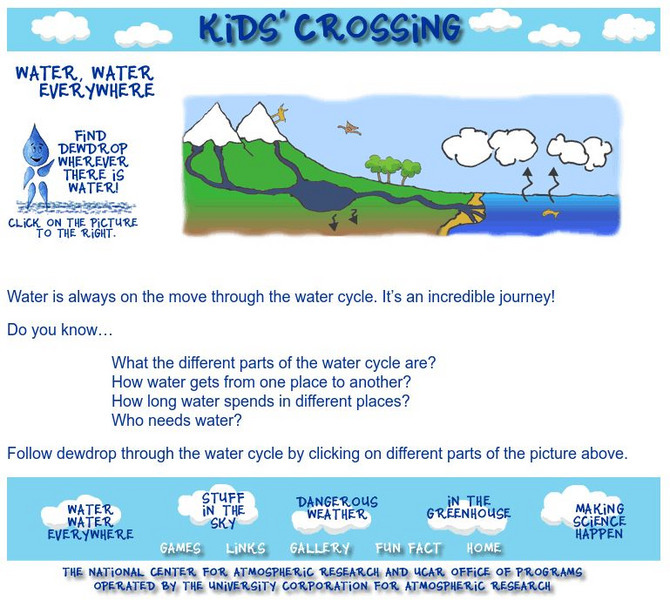Curated OER
Communities and Biomes
In this biomes learning exercise, students complete a crossword puzzle by figuring out the answers to 17 clues focused on communities and biomes.
Curated OER
Weathering Landforms
Fifth graders brainstorm a list of ways the Earth's surface can change. As a class, they are introduced to the concepts of erosion and weathering and discover how wind and water cause changes to the surface of the Earth. To end the...
Curated OER
Go Glacier Go!
Students create a model of a glacier and observe how it moves. In this landforms lesson plan, students learn what a glacier is, build a model glacier and observe how it moves in a manner that more closely resembles a liquid than a solid.
Curated OER
Investigating Fresh Water Ecosystems
Sixth graders examine the fresh water ecosystems. In this environmental lesson, 6th graders work in groups to collect information about a fresh water ecosystem and report their findings to the class in the form of a brochure.
Curated OER
Observing Sea Ice
Students study and observe types of sea ice found in Alaska. In this sea ice lesson, students use the student network for observing weather to study the different types of sea ice. Students study sea ice depicted in Alaskan art.
Curated OER
Walking on Frozen Ground
Students listen to an Elder speak about permafrost structures in their area. In this permafrost lesson plan, students listen to the guest speaker, take a tour outside to view permafrost structures, and draw them.
Curated OER
Landforms Word Search Puzzle
In this types of landforms word search activity, students will find and circle the names of 15 different kinds of landforms such as volcano and mountain.
Curated OER
Plop! Plop! Fizz! Fizz!
Fourth graders study physical and chemical weathering. They explain how the processes of weathering and erosion change and move materials that become soil. They create a K-W-L chart to show what they know and list what else they would...
Curated OER
Regolith Formation
Students compare and contrast the process of regolith formations. In groups, students define regolith and discover how regolith is formed on the Earth and on the Moon. They participate in experimental activities to simulate regolith.
Curated OER
Seasons
Students name the 4 seasons, discussing the weather, plant life, animal life and and activities of each. Students read the book titled, "Hello Arctic," and and discuss changes in seasons that accompany the story. Students complete...
Curated OER
Coral Mania
Students examine deep-sea coral. In this coral lesson, students identify the structure and function of a coral polyp. Students then create a model of a coral polyp.
Curated OER
Fenwick Island, Maryland And Beyond: Who Owns the Sand?
Students examine beach processes and complex beach systems. They study the human efforts to stabilize an unstable environment can lead to complex problems.
Curated OER
Alaska's Physical Systems and History
Middle schoolers read about Alaska's physical systems and determine how Alaska's physical makeup has impacted its history. They create timelines of their particular physical system.
National Park Service
Rock Ranking
Junior geologists sort rocks and soil. They separate a sample of river gravel by size, shape, color, and other characteristics. To include Common Core standards, you could have little ones graph the number of particles in each sample.
Curated OER
Model Penguin Project
Students research and build model penguins. In this penguin lesson, students examine the anatomy of penguins by creating models and completing coloring pages.
CK-12 Foundation
Ck 12: Earth Science: Glaciers
[Free Registration/Login may be required to access all resource tools.] Describes what glaciers are.
CK-12 Foundation
Ck 12: Earth Science: Glaciers
[Free Registration/Login may be required to access all resource tools.] Describes what glaciers are.
University Corporation for Atmospheric Research
Ucar: Water, Water Everywhere
Dewdrop teaches the water cycle through this interactive map of rivers, oceans, groundwater, the atmosphere, and glaciers.
US Geological Survey
Us Geological Survey: Glaciers and Ice Caps: Storehouses of Fresh Water
Locate glaciers and ice caps on a world map at this USGS site. Read about the formation of galciers and other interesting facts. Learn about the effects glaciers have on the landscape, and of their importance for our fresh water supplies.
US Geological Survey
Usgs: How Much Water Is There on (And In) the Earth?
The USGS gives an overview of the amount of water on Earth and where it is located. It gives a few interesting facts about the Earth's supply of water. Click Home to access the site in Spanish.
US Geological Survey
U.s. Geological Survey: Search
The U.S. Geological Survey offers information for teachers and students interested on Earth Science research. Contains references to general information as well as current research and events.
Annenberg Foundation
Annenberg Learner: Earth and Space Science: Restless Landscapes
Material to begin an exploration of the sand formation, landforms, and underground water. An hour-long video is accompanied by learning goals, an outline and overview, details on the ice ages, glaciers, and glacial landforms, and ideas...
Curated OER
Science Kids: Science Images: Iceberg
This beautiful image shows a unique looking iceberg in Greenland. There is a blue sky and the iceberg reflects off the cold water.
US Geological Survey
Usgs: Earth Surface Dynamics (Research Activities)
This site from USGS provides several activities to help understand the interrelationships among earth surface processes, ecological systems, and human activities. Also included are links to new findings and programs concerning Earth...























